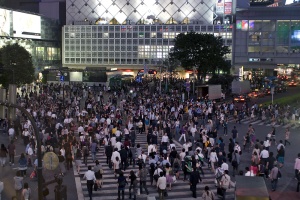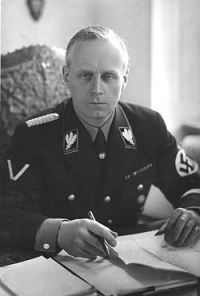It’s often a problem trying to decide where to meet friends in a busy city.
Spend any time in Tokyo, and you will soon notice that people are forever meeting other people, mostly at one of the 640 railway stations across the city, but in particular at two of the busiest Railway stations in the Japan; Shinjuku in the west and Shibuya in the south.
Shinjuku is a vast interchange station that boasts 38 platforms belonging to a dozen or more different railway companies. The trains roll into Shinjuku through four levels of basements up to the second floor elevated part of the station where passengers can walk effortlessly from train to department stores that are integrated into the station complex. There are numerous coffee shops, noodle stalls, and kiosks trading in every commodity. Over three and half million people a day pass through Shinjuku’s labyrinth; entering and leaving through nearly 200 entrances spread across half a square mile. This can be problematic when trying to decide where to meet in that small town of a station.
A couple of miles down the road is Shibuya station, the second busiest terminus in Japan, with a mere 2.5 million passengers a day. Servicing the southern suburbs and beyond; Shibuya is also the portal to the fashionable boutiques and up market style shops of Japan’s youth. The station has a main entrance on the west side, a large open square that opens onto the
world famous pedestrian crossing that traverses several roads on the junction and where up to a thousand people at a time can be seen crossing when the traffic signals are red.
In that square is a small statue of a dog – named Hatchiko. Oh yes – Shibuya is easy. “Let’s meet at Hatchiko” is all you need to say to any Tokyo resident and they will know exactly where you mean.
One day in 1925, Professor Ueno of Tokyo University walked to Shibuya station, as he did every morning, followed by Hachiko, his faithful Akita dog whom he’d taken in as a stray a year earlier. Each morning the dog would accompany his master to the station. Late in the afternoon Hachiko would return and wait for Professor Ueno to arrive back on his usual train. But on this day the Professor failed to return. He had been taken ill at work and had died.
The dog waited all night and all through the next day. Then the next day and the next. And so it was, that every day for the  next nine years that dog was back at Shibuya Station in the late afternoon hoping against hope that his master would return.
next nine years that dog was back at Shibuya Station in the late afternoon hoping against hope that his master would return.
The dog became a nuisance to the station staff who kept trying to shoo him away, undeterred; the dog kept returning. But one day a writer from the Asahi Shimbun newspaper wrote a story about the devotion and loyalty of Hatchiko to Professor Ueno and the dog became an overnight sensation across Japan. The dog was quickly revered as a symbol of family loyalty faithfulness that hit a cord in the population. The Hatchiko story was taught in schools across the country. Emperor Hirohito embraced the story and mentioned the dog in one his diary about loyalty to family and the state.
A year before Hachiko died, a statue was commissioned and erected at Western entrance to the station. There was a big ceremony at the station, and of course Hatchiko was the guest of Honour. The dog died the following March just outside the station. Crowds gathered and station staff was in mourning for days.
The bronze statue was melted down for the war effort, but when peace returned to the world, there was campaign to have the statue recast. The son of the original sculpturer was commissioned for the job and in 1948 Hatchiko was back at the west entrance which was named after the dog and where it still stands today. Every August 8th dog lovers from around the country meet at Hachiko to celebrate the friendship between man dogs. Films have been made about this remarkable dog and a very popular Japanese children’s book was written that is in most family homes.
Hatchiko is not unique in his devotion to his owner; indeed there are many instances of dogs who have attended a spot long after their master had died and have been remembered by a small plaque or memorial. But it was Hatchiko that reflected the zeitgeist of the time and for over 60 years has been the meeting spot for millions of people.
A less celebrated, but nonetheless remembered, a dog’s life marked with a Memorial, was Giro. Just at the top of the steps at Carlton House Terrace, leading down into the Mall, that red surfaced road which runs all the way up to the front door of Buckingham Palace. Hidden at the foot of a tree, behind some metal railings is a small head stone enclosed in a glass fronted wooden box dedicated in German to – “GIRO – A true Companion”
Giro, an Alsatian was the true companion of Leopold von Hoesch, the then German Ambassador to Britain. In 1934, Giro chewed through a power cable and was electrocuted. So a little grave was dug for him, and a headstone erected just outside the Embassy.
Hoesch was a consummate diplomat. After a time as Ambassador in Paris, where he helped to heal wounds between Germany and France after WW1, he was sent to London where he became
very popular with the British establishment. His heartfelt mission was to improve relations between Germany and Britain; to reduce the risk of another world war breaking out in Europe.
With the burning of the Reichstag in Berlin, and sudden rise of the Nazi party taking a stranglehold on German society, Von Hoesch must have realised his hopes of peace were soon to be dashed. When Hitler invaded the Rhineland, Von Hoesch protested in cables to Berlin, warning that this would lead to War with Britain and France. The embassy in Carlton House Terrace was increasingly being re-staffed by Nazi apparatchiks for whom the Ambassador had the upmost distaste. But he still kept protesting to Berlin about the way they were undoing his delicate work of building bridges with Germany’s neighbours.
Having provoked Hitler’s displeasure, he was in imminent danger of being recalled to Berlin, but he suddenly died of a heart attack in his Embassy bedroom. He was quickly replaced by the deadly Joachim Von Ribbentrop – who, a decade later, was executed for war crimes..
Ambassador Von Hoesch was given the equivalent of a State Military Funeral procession from the Embassy to Victoria station, and then onto Dover where a ship would repatriate him to Germany. His coffin, draped in a Nazi flag, was carried up the Mall on a guin carriage, past Buckingham Palace and was hailed by Nazi Salutes from the Terrace of the Embassy. In St James Park the army put on a 19 Gun Salute, and the solemn procession was accompanied by members of the Coldstream Guards as it made its way to Victoria Station. Three years later, these same Guardsmen would be fighting the advance of the Nazis across Europe.
There is an urban myth that Giro’s modest headstone is the only Nazi memorial in London. Nothing could be further from the truth. Although technically, Von Hoesch was the Ambassador for the Third Riech in London – he detested everything the Nazis stood for. Whereas Hachiko’s statue is a memorial to devotion and loyalty, Giros’ little headstone should be a monument to a man who dared to stand up to tyranny and evil and who remained loyal to fundamental human values of goodness.










Oh, welcome back! I thought you had just come back from Japan, but luckily I finished reading the whole post.
What an interesting twist and connection to these stories. I love them. Now I know about Ambassador Von Hoesch and can see the WWII slightly differently. History becomes more real when you can feel the emotions of the people living through the time. It offers more perspectives.
Next time I visit Buckingham Palace again and I’ll look for Giro’s headstone. I’ve just seen the magnificent display at Buckingham Palace a few weeks ago.
Welcome back!
Hi Janet,
yes I’ve been away working on a film for weeks. There was no time to blog. I wish I had been to Japan. One day soon I hope.
I have missed reading you all. I’ve a lot of catching up to do.
Do check out this little memorial. I was told about it recently, and I went and found it and was amazed at a little bit of hidden London.
What a great post. Thank you.
Thanks Bill. That was a great read and I will certainly take time to look for the Giro head stone the next time I am in London. It is history that puts the excitement in travel.
Thanks visit my blog. I remember stopping by your blog perhaps 2 years ago because I remember the seashell collection. I am now collecting clouds. No storage problem.
That was a beautiful story of Hatchiko, and it touched me here in Jerusalem in much the same way as it touched the many Japanese who visit the statue. I do enjoy the way you tell a story.
Great post, Bill, very interesting and informative!